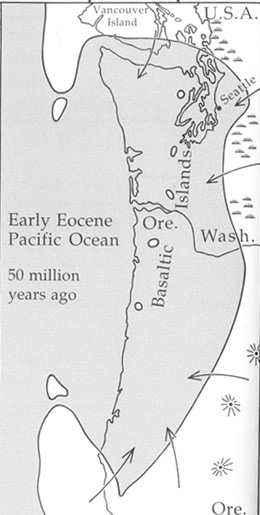About 100 million years ago, in the late Mesozoic Era, the Okanogan terrane (microcontinent) docks against the North American continent. This collision adds to the land mass of North America and extends the coastline of the Pacific Northwest about 50 miles farther west. Before the Okanogan terrane docking, the coastline ran along the present-day Idaho-Washington border. In the formation of the Pacific Northwest region over millions of years, there have been some 50 terrane dockings. These dockings, along with plate-tectonics (the sinking of the Pacific plate underneath the North American plate), tremendous volcanic episodes, and the advance and retreat of glaciers contributed to the Puget Sound landscape that we know today.
The next major terrane docking occurred 50 million years ago, and is known as the "North Cascades" terrane. This microcontinent crunched against the Okanogan terrane, again adding to the land mass of North America, moving the coastline still farther westward to a line running from Bellingham to North Bend through Enumclaw. (The site of present-day Seattle was still under seawater.) The North Cascades terrane docking event was followed by a vast period of volcanic activity (between 14 and 7 million years ago).
The last terrane arrivals occurred beginning 15 million years ago. This succession of terrane dockings, one following another, formed Vancouver Island (a group of terranes known as Wrangellia terranes), the San Juan Islands (the San Juan terranes), and finally a new arrival (the Olympic terrane) that crunched into the Wrangellia and San Juan terranes to the north and into the North Cascades terrane to the east. The Olympic terrane docking event pushed up the Olympic Mountains.
The Olympic terrane was carried on its collision course toward North America by the sinking of the Pacific plate. This action of plate-tectonics, combined with terrane dockings, formed the Puget Sound trough, which was in place at the beginning of the Pleistocene Epoch. The Pleistocene Epoch began about 2.2 million years ago, and is often called the Ice Age. It was characterized, not by continuous ice, but by the advance and retreat of glaciers.

